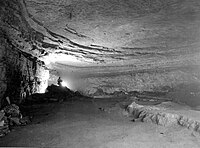
Photo from wikipedia
The soil above on a cave may act as a regulator of the changes occurring in and on the cavity, modifying water infiltration and retention and providing organic matter, clay… Click to show full abstract
The soil above on a cave may act as a regulator of the changes occurring in and on the cavity, modifying water infiltration and retention and providing organic matter, clay minerals, and nutrient elements, all of them essential for the growth of microorganisms and precipitates inside the cave. We assessed the mineralogical and geochemical composition of the soil lying upon Nerja Cave (Málaga, S Spain), as well as its textural properties and some biochemical parameters. At the same time, the isotopic composition of rainwater, drip water and current carbonate precipitated in Nerja Cave was monitored to establish relationships among them. In situ precipitation measurement dishes were placed in strategic areas of the cave, and environmental variables—temperature, humidity and CO 2 content of the air—were recorded. The soil sample composition, despite some variation with distance to the cave entrance, can be considered quite homogeneous. Carbonate precipitates do not show dissolution traces. Isotopic data obtained from carbonate precipitates and drip water show an isotopic lightening of δ 18 O throughout the entire process. The most anthropized soils favor higher water infiltration rates, thus affecting the precipitation of carbonates inside the cave. A significant inverse relationship was observed between the δ 13 C values of the precipitates and the drip water rates. Environmental parameters and soil properties affect carbonate formation in Nerja Cave. Microorganisms in precipitates related to soil organic C in visited areas of the cave. High drip water rates related with soil porosity and fractures in the bedrock. A relationship found between δ 13 C in carbonate precipitates and drip water rate. Rhombic calcite/fibrous aragonitic crystals depending on the location in the cave.
Journal Title: International Journal of Environmental Research
Year Published: 2020
Link to full text (if available)
Share on Social Media: Sign Up to like & get
recommendations!